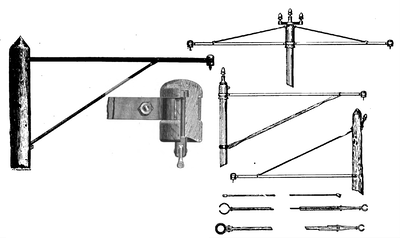[Trade Journal]
Publication: The Electrical Engineer
New York, NY, United States
vol. 10, no. 131, p. 509-510, col. 2,1
NEW BRACKET ARM AND INSULATOR FOR
ELECTRIC RAILWAYS.
The accompanying cuts shows a new form of bracket arm which attracted much attention at the recent Buffalo Street Railway Convention, and which has several distinct advantages over the existing forms. The cut shows the simplest possible form, although the same principle readily admits of ornamentation. The arm consists of two flat bars bolted together. At their inner end they are bent apart so as to partially clasp the pole, and have holes near their extremities by which the arm is attached to the pole with lag screws. A brace clamped between the two bars supports the arm from above or below. The outer ends of the bars are so shaped that when clamped together they embrace and hold an insulator specially designed for the purpose. The insulator is firmly held in a vertical position, and a brass foot is riveted into a malleable iron stem with a stout and deeply forked end. This admits of free oscillation of the foot in the line of the wire, but no lateral movement. The advantages of this arm are its great simplicity and strength. It is attached to the pole in such a manner that a break or slacking of the wire will not injure it or its attachment to the pole. It is suitable for curve and straight line work. The insulator is strong and efficient, and exactly suited to the work required of it. This form of bracket arm is made also for use with iron poles, in which case it clamps at the inner end to an insulated iron pole top of special design, and is so arranged that the entire bracket arm is insulated from the pole. These devices are manufactured by Emmet Bros., of this city. They are being used in large quantities by the North American Construction Co., of Pittsburgh.
 |
| New Bracket Arm and Insulator for Electric Railways. |
